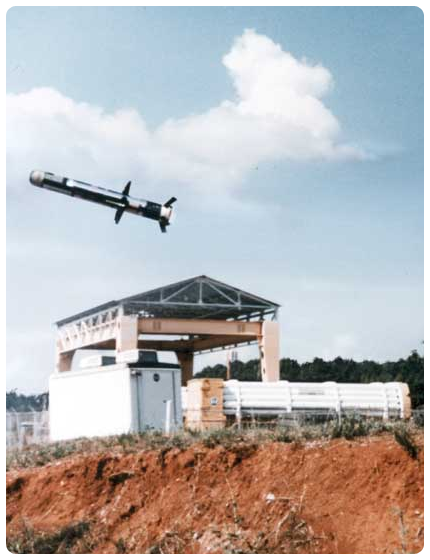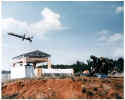The JAVELIN is a manportable, antitank system developed for the U.S. Army and U.S. Marine Corps (USMC). Highly lethal against tanks with conventional and reactive armor, JAVELIN will provide a medium antitank capability to the infantry, scouts, and combat engineers. A simple-to-operate, economically maintained, rugged and reliable infantry system, JAVELIN has two major components: a reusable Command Launch Unit (CLU) and a missile sealed in a disposable Launch Tube Assembly. The CLU incorporates an integrated day/night sight and provides target engagement capability in adverse weather and countermeasure environments. The launch unit also may be used in the stand-alone mode for battlefield surveillance and target detection.
For operation of the system, the round must be mated with the CLU. The missile, with a warhead designed to defeat both conventional and reactive armor, may be used at the gunner's discretion in top attack or direct fire mode. Top attack is the normal mode of operation, while direct fire is for engaging targets under cover. The key feature of the JAVELIN is the use of fire-and-forget technology that allows the gunner to fire and immediately take cover. Additional special features are the advanced tandem warhead, imaging infrared seeker, target lock-on before launch, and soft launch (the JAVELIN can be fire safely from enclosures and covered fighting positions). JAVELIN is designed to replace the DRAGON.
View more JAVELIN photos

System Chronology
|
12 December 83 The VIPER Project Office was redesignated the Advanced Manportable Weapon System (AMWS) Project Office (Provisional). Approval of the charter delayed the pending decision on the Advanced Antitank Weapon System-Medium (AAWS-M) program. The renamed office was responsible for residual VIPER (a replacement for the M72 Light Antitank Weapon) activities; two other possible M72 replacements (the AT-4 and the M72E4 production improvement program); and the AAWS-M. 13 April 84 The Deputy Chief of Staff for Research, Development, and Acquisition approved the acquisition strategy for the AAWS-M, which involved using competitive contractor teams. 11 July 85 The Assistant Deputy Chief of Staff for Operations and Plans, Force Development, DA, signed the required operational capabilities (ROC) document for the AAWS-M. 3 September 85 The Under Secretary of the Army and the Vice Chief of Staff, Army (VCSA) signed the AAWS-M Decision Review Memorandum approving the AAWS-M and AAWS-Heavy (AAWS-H) programs for entry into a demonstration and validation phase. 1 January 86 The MICOM Commander approved provisional establishment of the AAWS Project Office. The renamed office assumed a new mission: management responsibility for the AAWS-H program. It also retained responsibility for the AAWS-M, AT-4, and M72E4 product improvement program (PIP). 2 May 86 The request for proposal for the AAWS-M proof of principle (POP) phase was released. 15 May 86 The Office of the Secretary of Defense (OSD) issued the Defense Systems Acquisition Review Council (DSARC) I Decision Memorandum authorizing AAWS-M to proceed with the demonstration and validation phase as defined in the 11 April 86 DSARC I. 28 August 86 Contracts for the AAWS-M technology demonstration POP were awarded to three companies: Texas Instruments, Hughes Aircraft Company, and Ford Aerospace and Communications Corporation. 1987 MICOM formally requested that the AMWS Project Office be redesignated the AAWS Project Office, since the original name no longer reflected the organization's mission. 30 July 87 Competitive contracts for the alternate warhead effort for the AAWS-M were awarded to DynaEast of Philadelphia, Pennsylvania, and Aerojet, Tustin, California. 1 October 87 AMC approved the redesignation of the Office of the Project Manager, VIPER to Office of the Project Manager, AAWS. February 88 The AAWS-M alternate warhead program started as a parallel effort to the AAWS-M POP phase. 6 September 88 The request for proposal for the AAWS-M full-scale development (FSD)/low rate initial production (LRIP) award was released to industry. December 88 The 28-month AAWS-M POP program concluded this month. March 89 The alternate warhead program was completed. The goal of this effort was to lower the technical risk associated with the warhead subsystem development. 21 June 89 The AAWS-M FSD contract was awarded to the Joint Venture contracting team of Texas Instruments and Martin Marietta. August 89 A memorandum of understanding (MOU) between MICOM and Defense Advanced Research Projects Agency (DARPA) was extended to effect transfer of Infrared Focal Plane Array (IRFPA) technology from the DARPA IRFPA to MICOM-managed missile systems. The project office would received five IRFPAs from DARPA contractors. These arrays would be configured to AAWS-M seeker FPA specifications and tested by the AAWS-M prime contractor and MICOM's Advanced Sensors Directorate. 25 October 89 The AAWS-M alternate warhead contract was awarded to Conventional Munitions Systems (CMS), the U.S. subsidiary of Messerschmitt-Boelkow-Blohm GmbH. The contract would investigate alternate warhead designs within the AAWS-M envelope. Critical performance requirements included reduced warhead weight and improved warhead effectiveness against threat armor. January 90 Qualification testing of the AAWS-M warhead began. September 90 A joint venture team was created to study the producibility of the Electronics Safe Arm and Fire (ESAF) Accelerometer in order to improve yields above the current 42 percent. The Santa Barbara Research Center (SBRC) delivered a focal plane array (FPA) to the AAWS-M FSD program that met the AAWS-M FPA specification. November 90 The AAWS-M Baseline Test (BST) was conducted to address the system's current performance capability in the robust combat environment required by the 17 June 89 Addendum to the Acquisition Decision Memorandum (ADM). Completed in March 91, the tests indicated that AAWS-M met or exceeded the existing criteria for Phase I and Phase II testing. FY 91 The AAWS-M Project Office was renamed the JAVELIN Project Office. The redesignated organization was responsible for managing the JAVELIN (as the AAWS-M was now known) and the Multipurpose Individual Munition (MPIM), which was later transferred to the MICOM Research, Development, and Engineering Center (RDEC) for further development. 27 September 91 An ADM was signed, approving a 54-month Engineering Manufacturing Development (EMD) program for JAVELIN. FY 92 The JAVELIN deployment schedule was modified to reflect the downsizing of the Army and USMC. 1 December 92 A training Force Development Test and Experimentation (FDTE) of the JAVELIN system began at Fort Benning, Georgia. Completed on 30 April 93, the FDTE was conducted to determine the best initial gunner training program. 24 March 93 The first JAVELIN round to be man fired was a telemetry round fired by a contractor gunner. 14 April 93 The Portability test of the JAVELIN system began on this date at Aberdeen Proving Ground, Maryland. The program, which lasted until 14 May 93, included obstacle and cross country course testing, preparation fire testing, vehicle compatibility testing, and clothing compatibility testing. A total of 21 soldiers and Marines participated in the tests, which demonstrated that JAVELIN met its manportability requirements. 1 July 93 The first round fired by a military gunner occurred on this date. 22 August 93 The first tactical warhead round fired by a military gunner was launched on this date. FY 94 The JAVELIN round was officially designated as a Category I sensitive ammunition item requiring special handling. February 94 JAVELIN completed the EMD phase. 23 June 94 The JAVELIN LRIP I main effort contract was awarded to the Joint Venture. 9 March 95 The Joint Venture Texas Instruments and Martin Marietta received a contract for the JAVELIN LRIP II effort. 29 September 95 A JAVELIN roll-out ceremony was held at the Lockheed-Martin facility in Troy, Alabama. The first two JAVELIN missiles were officially delivered to the government at that time. June 96 The LRIP II Product Verification Test (PVT) system qualification test program was successfully completed. Included in the testing were 25 rounds and 7 CLUs from the LRIP I production lines. This hardware incorporated the design and process changes from the EMD phase and reflected the current production processes at both the round and CLU production facilities. 27 June 96 The JAVELIN achieved first unit equipped (FUE) status with the fielding to the 3d Battalion, 75th Ranger Regiment at Fort Benning. 29 February 96 The LRIP III contract was awarded to the Joint Venture. |
JAVELIN Photos

|

|

|
